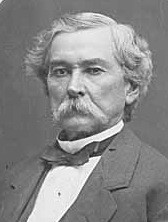Biographical Details
Date of Birth: January 12, 1814
Birth Location: Flemingsburg, KY, USA
Major Study: Law
Graduation Year(s): 1845
Degree(s) Earned: Bachelor of Laws
Date of Death: May 20, 1876
Death Location: Saint Paul, MN, USA

Date of Birth: January 12, 1814
Birth Location: Flemingsburg, KY, USA
Major Study: Law
Graduation Year(s): 1845
Degree(s) Earned: Bachelor of Laws
Date of Death: May 20, 1876
Death Location: Saint Paul, MN, USA
Willis Arnold Gorman was an only child, who was educated at home. His family moved from Kentucky, where he was born, to Bloomington, Indiana. He was admitted to the bar in 1834, while still a law student, attending Indiana College (now IU). He interrupted his studies, became an attorney-at-law, and was an active member of the Democratic Party. He worked his way up from clerk in the Indiana State Senate in 1837 to be a representative in the Indiana State Legislature from 1841 to 1844. He returned to IU and completed his studies, graduating with his law degree in 1845.
In the Mexican War, Gorman enlisted as a private and was promoted to major of the 3rd Regiment of Indiana Volunteers and then colonel of the 4th Indiana Regiment of Indiana Volunteers. He fought in the Battles of Huamantla, Atlixco, Tlaxcala, El Peñol, Puebla, and Buena Vista, where he was severely wounded while leading a rifle battalion. He became civil and military governor of the city of Puebla, Mexico, in 1848.
When Gorman returned from the war, he advocated publicly against slavery. He represented Indiana’s 6th District in the U.S. House of Representatives from 1849 to 1853. In 1857, he was elected a delegate to the Minnesota Constitutional Convention. From 1858 to 1859, he served in the Minnesota House of Representatives.
During the Civil War (1861), Gorman enlisted in the Union Army at age forty-seven. He fought in the Battles of Antietam, South Mountain, and Ball’s Bluff. He was colonel of the 1st Minnesota Infantry, and for meritorious service in the First Battle of Bull Run, he was promoted to brigadier general. His son, James, was with him as part of his staff. Gorman served in Arkansas until the end of the war, andthen returned to Minnesota, where he was city attorney for Saint Paul for the remaining ten years of his life. He was buried with civil and military honors.
In 1836, Gorman married Martha Stone in Bloomington. In 1859, his son, James, graduated from IU. James’s graduation program was among Gorman's prized papers found upon his death.
In 1853, President Franklin Pierce appointed Gorman the second governor of the Minnesota Territory. He also served as superintendent of the Bureau of Indian Affairs for the territory. He was criticized in the press for his tolerance and lenience toward Native Americans. He officially recognized the Red Wing band and their chief Wacoota, promoted agriculture and farming of prairie lands to the Dakota tribe, and purchased supplies for the Sisseton and Wahpeton Indians. His private secretary during this time was fellow IU alumnus, Robert A. Smith, who would go on to become mayor of Saint Paul.